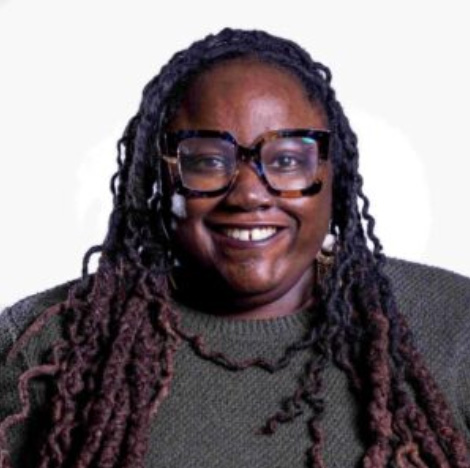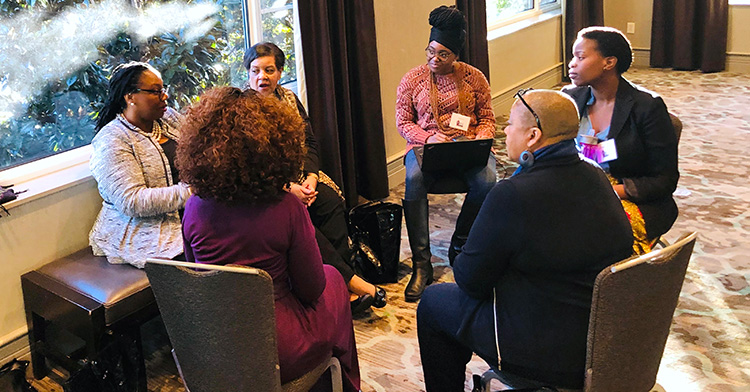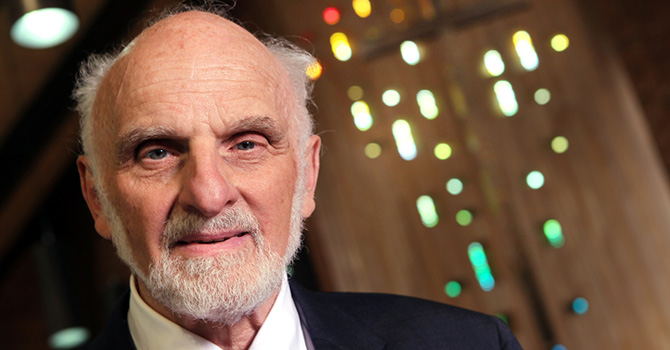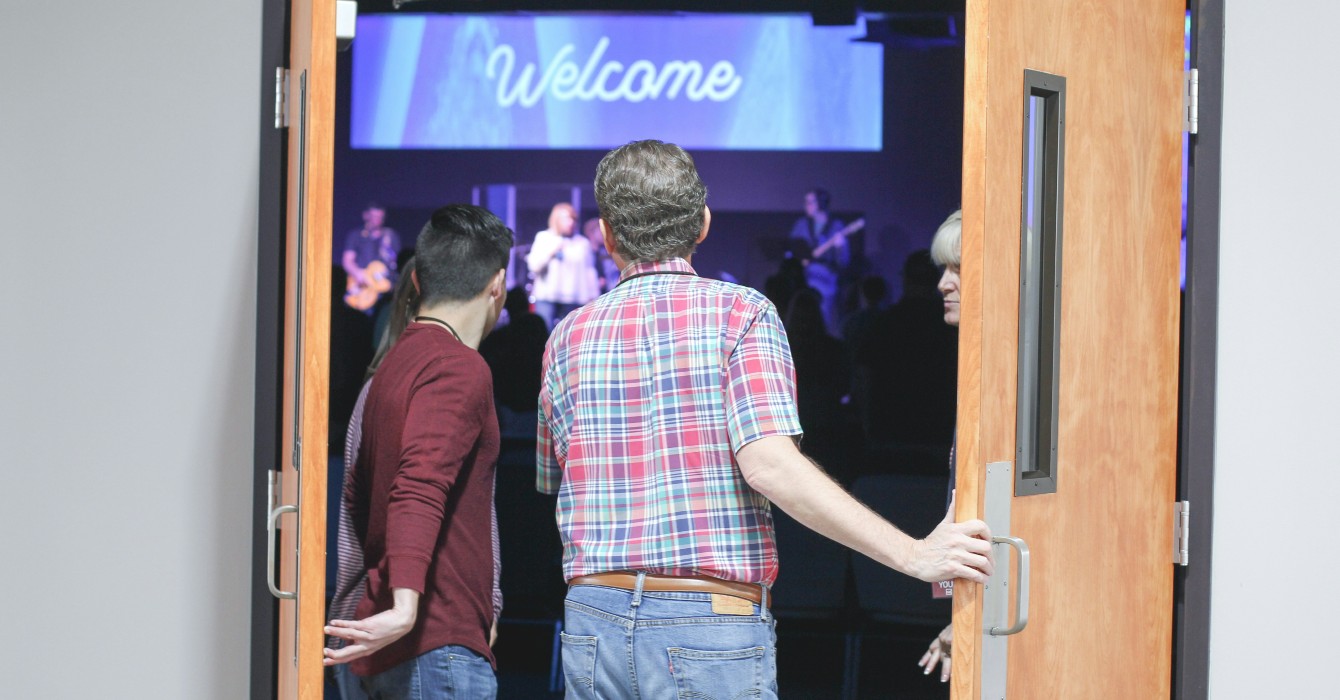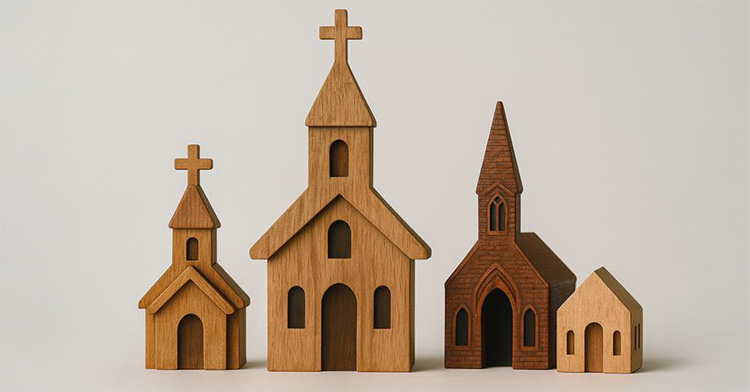On a humid Thursday evening in September, the Rev. Cynthia Kepler-Karrer, the pastor of Memorial United Methodist Church in Austin, Texas, looked at the lump of beige dough in her hand and laughed. What was supposed to become a delicious babka -- flavored with her special ingredient, almond paste -- was now useless.
Kepler-Karrer had become so engaged in a conversation that she accidentally poured several tablespoons of salt -- instead of sugar -- into her mixing bowl.
“You can’t use it?” asked a visitor to Bread Church, Memorial’s monthly gathering where participants bake bread and discuss the spiritual metaphors that arise naturally from the process -- topics like leaven, new life and transformation.
The 45-year-old pastor shook her head and explained that she’d killed the bread’s ability to rise.
“The Gospel says, ‘Have salt in you,’” she joked later. “I think Jesus forgot to say, ‘And not too much.’”

The failed babka didn’t faze Kepler-Karrer, who wore a silver cross and practically bounced with enthusiasm when she talked.
That night felt victorious. She watched connections form around the stainless steel tables in the church’s industrial-size kitchen. Longtime church members mixed ingredients and kneaded dough alongside unaffiliated millennials searching for community, a pair of elderly women who came just to socialize and an associate pastor from Austin’s downtown United Methodist church seeking inspiration.
Bread Church is one of many outreach programs Kepler-Karrer has launched since arriving at Memorial five years ago, one of many small victories for a congregation with an all-too-familiar story. After years of decline, Memorial has the hallmarks of many mainline Protestant churches today -- low attendance, financial struggles, an aging congregation and worries about long-term survival.
But Kepler-Karrer and church members are too busy to plan their funeral. They are baking bread with neighbors, coordinating ESL classes for immigrant parents and inviting an assortment of community groups -- from the Austin Ukulele Society to Meals on Wheels -- into their space.

Moving forward despite fear and doubt
For churches grappling with similar challenges, Memorial offers important lessons for moving forward in ministry even in the face of fear and doubt. Under Kepler-Karrer’s guidance, congregants are embracing a decidedly Wesleyan model of church focused not on themselves but on their neighbors.
In this new yet very old mission field, they’re moving toward measuring success not by attendance and donations but by how many people are using the church building and how many neighbors are being served.
How does your church or organization measure success? What new marks of success might it be overlooking?
The surrounding Northeast Austin neighborhood, known as Windsor Park, is currently a blend of Hispanics and African-Americans, immigrants and young white gentrifiers. It’s not exactly fertile ground for a mainline Protestant church in decline, especially one that is mostly white and elderly, with an average Sunday attendance of 65 to 75.
But Kepler-Karrer and the congregation are making inroads by keeping their focus on faithfulness.
“I’m pretty clear that my job is to be faithful every day and to notice God working every day and to keep pointing that out and to keep inviting people in and welcoming people in and introducing people to Jesus, who has a message about a kingdom,” Kepler-Karrer said. “If I’m doing that, then I’m being faithful, and I think I’m called to be faithful, not just to save a church.”
Founded in 1873 by Swedish Methodists, Memorial -- first called Swedish Methodist and later Central Methodist -- originally occupied land near the Texas Capitol downtown. In the late 1950s, the church sold its property to the state and moved to Northeast Austin, where developers were transforming farmland into a neighborhood for young families -- ranch-style homes with all the modern conveniences.
Memorial’s move to Windsor Park was perfect timing for young couple Carole and Charles Garner, who had settled in the new neighborhood and were looking for a church home. Their two children were baptized and confirmed at Memorial, and Charles took an active role in building the gymnasium and opening a church school.
Memorial, with its high wood-beamed ceiling and elegant stained-glass windows, thrived in those years, said Carole Garner, now 82. Sunday worship drew 600 to 800 people. The congregation required three services at Easter and fielded dozens of confirmation candidates each year.
Staggering decline
Garner said the church’s subsequent decline has been staggering, as church members have died or moved away and the surrounding neighborhood’s profile has changed, becoming less white and more economically challenged.
Charles died in 2013, and Carole now lives in a townhome nearby. She’s encouraged by Kepler-Karrer’s efforts to engage the neighborhood but worries that Memorial may not survive.
“Truthfully, I can’t say that I see a long-term future,” she said. “I just hope we don’t lose the church.”

On Kepler-Karrer’s first Sunday at Memorial five years ago, the pastor looked out from the pulpit at the gray-haired parishioners sitting on mustard-colored pew cushions and realized that she and her husband were the only people there between the ages of 18 and 40.
Kepler-Karrer wasn’t intimidated. She’d served struggling churches before. At her second appointment after seminary, a tiny congregation in a town called Runge, the church had burned down one Sunday, the result of a faulty thermostat.
Her father, the Rev. Kent Kepler, is a retired United Methodist pastor who served mostly rural Texas churches. She grew up in cramped parsonages and graduated from high school in a county that boasted the highest goat population in the United States.
Church leaders in every denomination have long urged pastors to take on the type of outreach Memorial does regularly -- such as supporting local schools -- but there’s no denying the pressure to demonstrate some kind of measurable success. How would Kepler-Karrer convince people in the conference that Memorial still had life in it?
The key was staying focused on the mission field, which Kepler-Karrer sees as the world just outside the door of the parsonage she shares with her husband, Clayton Karrer, and their dogs and cats.
What is your church's primary mission field?
Fragmented landscape, still evolving
The densely populated Windsor Park, just east of Interstate 35, is a fragmented landscape that is still evolving. Once white, middle-class and suburban, the neighborhood became more racially and economically diverse as original residents moved out, often renting their homes to Hispanic and African-American tenants.
More recently, the area started attracting new investors, as the nearby site of Austin’s former airport was transformed into an upscale development featuring eco-friendly homes, lush parks and trendy restaurants. As a result, home values and property taxes have risen dramatically throughout Windsor Park, putting pressure on many low-income residents.
Sprinkled among the newly renovated houses, adult group homes and low-income apartments add to the neighborhood’s economic mix. And immigrants from Mexico and Central America are now being joined by newcomers from East Asia and Africa, adding to the racial mix.
Kepler-Karrer realized that her church couldn’t possibly do the work of Jesus if they didn’t know their neighbors. So in keeping with her Wesleyan approach to community building, she began a walking tour shortly after her arrival, meeting as many residents as she could and finding out their needs.
“Methodists have been involved in structures of getting food to people and getting education to people and getting health care to people for a very long time,” she said.
Her efforts haven’t always gone exactly as planned. Memorial’s motto -- “Feeding Northeast Austin, body, mind, and spirit in the name of Jesus” -- dovetailed nicely with the monthly bread-making gatherings that the church already was hosting. So Kepler-Karrer suggested that congregants expand the ministry by offering fresh loaves to people in the neighborhood. It would be a symbolic gesture that could lead to conversations and, ultimately, relationships, she thought.

But the practical implementaion of this idea wasn't easy. Some people they approached were understandably suspicious of strangers giving them food. Kepler-Karrer discovered bread discarded on neighborhood benches.
“If somebody hands you a random loaf of bread at a bus stop, maybe you don’t eat that,” she said with a laugh.
Still, church members kept trying. And eventually some neighbors -- including a street preacher with a megaphone -- began showing up at Sunday services.
‘Strange people’ coming to church
The interactions pushed some members out of their comfort zone, and more than a few noted that some “strange people” were coming to church.
Kepler-Karrer’s response: “Yeah, isn’t it awesome?”
Who does your church consider “strange?” If they attended, would that be "awesome," or just strange?
Not everyone thought so, but for the most part, the congregation welcomed the newcomers. They even agreed to change the name of their annual homecoming service from Roundup Sunday -- which Kepler-Karrer feared would trigger a negative reaction among Hispanic immigrants -- to Y’all Come Sunday.
Kiki Corry, who grew up a mile from the church and was confirmed there in 1970, said she’s always thought of the neighborhood as the “extended family” of Memorial, even as the demographics have changed.
“As a biologist, I appreciate the importance of diversity for resilience,” said Corry, an official with the Texas Parks and Wildlife Department. “I see this neighborhood becoming stronger because of this diversity.”
Three years ago, Kepler-Karrer made a decision. When asked where she served, she would name the mission field first -- Northeast Austin -- and then Memorial UMC. When giving her annual report to Methodist officials, she would begin with an update on the neighborhood and how her congregation was serving the people of Windsor Park.
She also recently began working toward a new metric of success at Memorial: the number of “person-hours” per square foot.
Attendance may be paltry and finances thin, she figured, but the church does not sit empty throughout the week. It fills an assortment of needs. The sprawling complex, which includes a gymnasium, a kitchen, classrooms and meeting rooms, accommodates charities, church organizations, Scout troops, the neighborhood association, artists and others who need space.
The church is still gathering data from the various organizations, but Kepler-Karrer estimates that the groups who use the building weekly, for example, account for nearly 300 person-hours per week. She’s still gathering information from organizations that meet at the church monthly, but as the church compiles more solid and complete data, it hopes to track those benchmarks and see ongoing improvement.
Called to build relationships
Capital District Superintendent Teresa Welborn has been impressed by what she described as Kepler-Karrer’s “theological understanding of the incarnation.”
“As disciples, we are called to build relationships with others in the mission fields we seek to serve, to share resources and learn from one another,” she said.

Welborn has great hope for Memorial and points to Jeremiah 29:11 as offering an important message for the church: “I know the plans I have in mind for you, declares the LORD; they are plans for peace, not disaster, to give you a future filled with hope” (CEB).
One of Memorial’s most ambitious endeavors is the ESL program for parents of students at Harris Elementary School, located just across the street. The school’s student body is 80 percent Hispanic and 9 percent black, and almost all of its students qualify for free or reduced lunch.
The church launched the ESL classes in January in partnership with Austin Independent School District and Manos de Cristo, a nonprofit that provides assistance to people with low incomes. .
Carol Logan, Memorial’s volunteer coordinator for the program, said the church already had a relationship with the school, supplying pencils to students for standardized tests and bringing casseroles to teachers. When Logan inquired about other ways Memorial might help, school officials told her they desperately needed an ESL program for students’ parents.
How does your church know what people in the surrounding community need and want?
Twelve people, including two women from Sudan, completed the course last spring. Another class is now underway at Memorial. The church also provides child care for the parents. Logan watches a group of 3-year-olds twice a week.
One of the boys asked her recently as they walked into the church, “Is this your house?”
“Yes, well,” she replied, “my house is your house.”
Logan said she gets so much joy from her work with the neighborhood that she almost feels selfish. She didn’t imagine that was possible when she joined Memorial three years ago after moving into a nearby apartment complex. She was concerned that the church might be dying, but Kepler-Karrer’s passion for community engagement made her stay.
‘A center of the community’
“We don’t want the church to be a community center,” she recalled her pastor saying, “but we want it to be a center of the community.”

Sustaining that center is an ongoing challenge. Kepler-Karrer’s mission efforts have won praise from Methodist officials, but the church continues to face practical challenges such as building maintenance. The church has replaced several HVAC units in the past five years, and its budget is lean.
In an effort to find a path forward, the congregation earlier this year assembled a leadership team, which is still defining its work.
“It’s not even a light at the end of the tunnel,” Logan said, “but it’s the best way possible of dealing with this.”
Kepler-Karrer keeps reminding members that as Christians, they don’t fear death and shouldn’t fear their church closing.
“Even if this particular congregation can’t sustain itself, … this space will be in ministry somehow,” she said. “I see all kinds of pathways moving forward for this congregation to sustain itself. I am very confident that whatever happens here will be ministry coming out of our space. And I have a feeling it will be Methodist in character.”

The Bread Church gatherings offer Kepler-Karrer a promising glimpse of what the future might look like as she guides people through the process of making dough and exploring divine metaphors. There’s something about mixing the physical and the abstract that draws people who might not otherwise set foot in her church.
Alex Klein, 26, read about Bread Church in Austin’s alternative weekly paper. He attended once by himself and the next month brought along his girlfriend, Tyger Nunez, 25.
The two don’t attend a church, but Nunez said she’s open to hearing spiritual discussions.
“We like to be involved in the community,” she said.
On that September evening, Klein and Nunez joined the others for conversation and prayer in the children’s Bible study room. Meanwhile, in the church kitchen, the dough for their babka and cinnamon rolls made its first rise.

Questions to consider
Questions to consider
- How does your church or organization measure success? What new marks of success might it be overlooking?
- What is your church’s primary mission field? What does it do to keep from becoming its own mission field, focused primarily on itself?
- What specific steps can your church take to connect more closely with the surrounding neighborhood?
- Who does your church consider “strange?” How welcome would they be at your church? If the stranger attended, would that be awesome, or just strange?
- How and in what ways does your church serve the community?
- What does your church do to find out what people in the surrounding community need and want?




